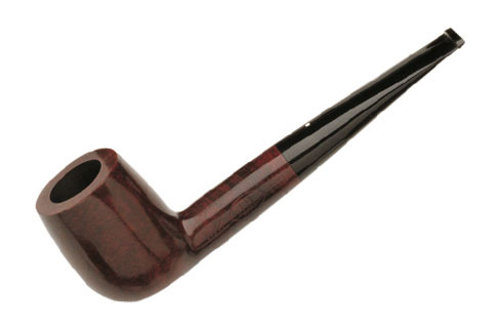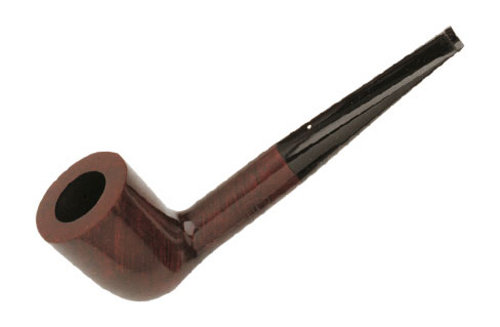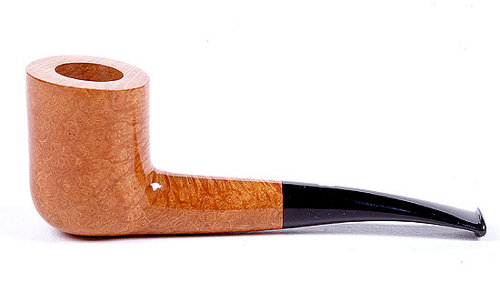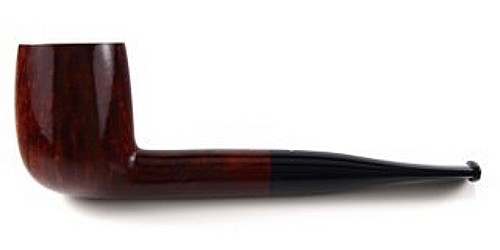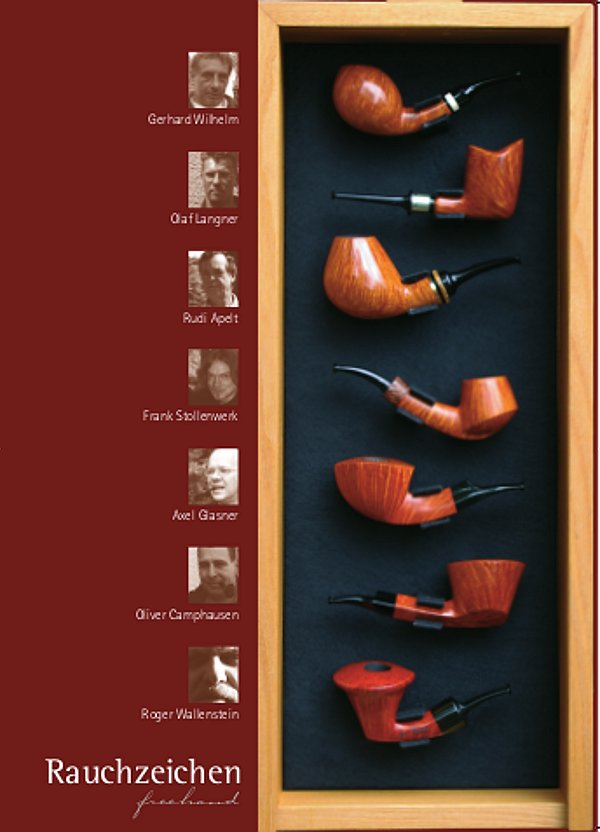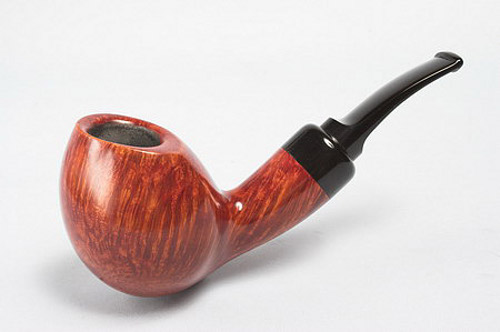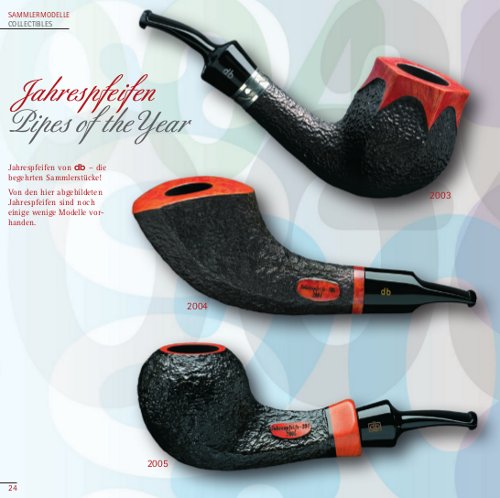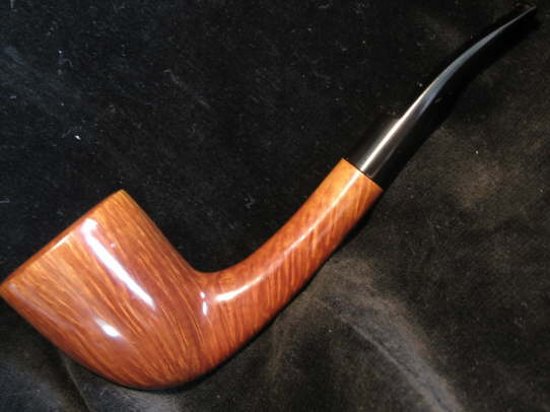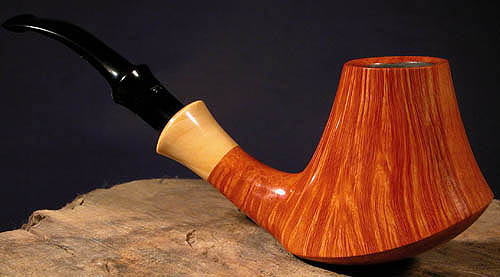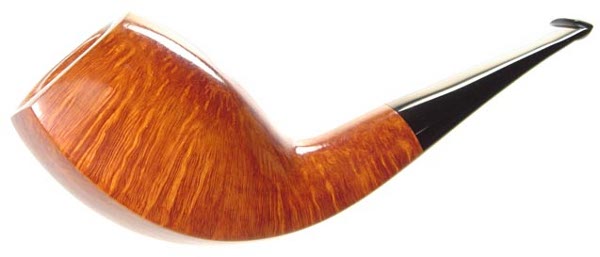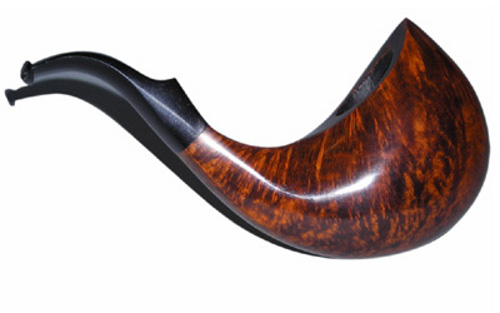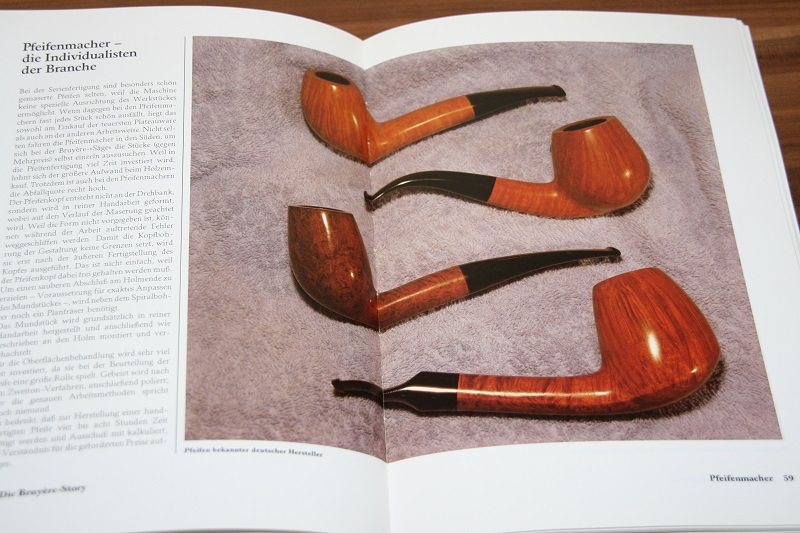Are you sitting down? Do you have a bowl full? Great, proceed...
I stumbled across this reproduced article which may settle this matter:
Credit: http://pipesmagazine.com/forums/topic/ww-ii-pipes
Written for and published by The Pipe Collector Feb. 2007.
Pipes Tobacco and Culture.
British Pipes. Part 1:
"When we think about schools or perhaps I should say styles of pipe making
we tend to group them into three, Classic English, Italian and Danish, with the Germans lumped in with the Danish.
In reality there are more, we can add American and Japanese, so we have 5 styles. The question I ask is why and how did such distinctive stylistic approaches come about. A pipe is basically a utilitarian object made from dead wood with two holes to smoke dried leaves in it. Yet, a pipe is far more. It can be a friend, an object of beauty even a status symbol. And most seasoned pipe smokers develop a preference for certain shapes and/or styles.
So to try and understand how the different schools developed I thought
the answer lies in the culture of the society it grew out of. Pipes are no more removed from cultural influences than clothing or furnishings.
We know that
briar pipe making started in France, mainly around St. Claude, yet the 1st recognizable style was the English briar pipe. Initially the British pipe shops imported pipes from France. We cannot be sure what the exact shapes were. But we know they were small as tobacco was expensive and still is in Europe. We can surmise that shapes were initially derived from the clays. There were straights and it is easy to see how the briar Woodstock and Dublin shapes evolved from the canted clay. The full bent probably evolved from the carved European Walnut wood pipes etc., as there were no full bent clays that I am aware off.
The 1st major step in the manufacture of British pipes was the arrival in London of Henri Comoy, (1850-1924), with some workers from St. Claude. He founded the H. Comoy & Co. Ltd. This was the time when the British Empire reigned supreme and one quarter of the earth’s surface was pink on world maps. It was the time when the idea of the British gentlemen was the worldwide epitome of class. So these new British made pipes had an instant home market.
All classes smoked pipes in pre WWI U.K. The working class mainly smoked the clays and the elaborately carved meerschaums were favored by the upper classes in Continental Europe. Both had no appeal to the style setting English gentlemen.
The clay was too mundane with no class, and in no way could be considered an article of quality.
The Meerschaum was much too gaudy, ostentatious and European.
The quality pipe makers who set the style and developed what we know call the classic English shapes, Billiard, Dublin, Canadian, bent, etc. earned their living by catering to the carriage trade; the upper classes, merchants, officers and the rapidly growing middle class.
The ideal of the carriage trade was the British gentleman. He was always polite to everybody, discrete in his behavior, and well dressed in a conservative manner. Gentlemen did not engage in trade and either went into the army, the government or did something in the City. The gentlemen of good taste demanded extremely well made goods that were understated. His city suit would be a bespoke three-piece discreet pinstripe and his casual suit was grey flannel and both were perfectly cut to bring out the best of his physic. His suits, coats, (jackets) had hand rolled labels, buttonholes on the sleeve that undid, a small outside pocket on the right side for bus/tube tickets etc. and still do. Nothing was there for purely ornamental reasons. His only splash of color was his tie, probably his school and his pocket puff. His pipes should be the same. Extremely well made, discrete with none of that European ostentation. The exception was an allowable sterling silver band on the pipe. No initials etc. on the band. Gentlemen didn’t monogram their clothes, so why would he do so on his pipe. A gentleman knows who he is and what his initials are.
He wore a dark suite when in the city and in the country wore a checked coat (jacket) with odd trousers.
His pipe had to reflect the same style.
It was not to stand out and should easily fit in his coat pocket.
So pipes were generally smaller, 5 1/2” was the normal length for a straight pipe. The pipe should fit into a breast pocket unobtrusively. Also, tobacco was expensive in England. Whether the cost of tobacco really affected the pipe sizes is debatable because Dunhills, Charatan, Barlings, Comoys etc. were not being bought by the average working man. An average premium pipe was 2 shillings; a Dunhill was 5 shillings 6 pence. When you consider that a good wage was 29/s (shillings a week), 10% of your income for an average pipe and double that for a Dunhill a quality pipe was a lot of money. Most working people in England spent 40%+ of their wages on rent and food was also expensive, so a quality pipe was way beyond their means.
A full bent was for evenings at home, in his club or weekends in the country. At home a gentlemen wore a smoking jacket. Often in padded red silk or velvet with black sateen collar facings. He also had a small portable smoking table that held an ashtray, tamper, cleaners, some tobacco and place for his favorite beverage. To be put beside his favorite chair. Some smokers at home also wore a Fez as a smoking hat. This was an age of great style.
Interestingly,
the full bent became acceptable because of WWI. Pre-WWI the only people who smoked full bents were manual workers, because
they needed their hands free. So the last thing a gentlemen would smoke was a full bent. In WWI, to be an officer in the British navy was to escape the carnage of the trenches, but you needed your hands free, to plot course, take readings etc. so the full bent was the only practical pipe to smoke on a British warship. After the war the full bent was no longer regarded as strictly a working class shape, but considered a navy shape. So it was acceptable for a gentlemen to smoke one. The whole of the premium pipe trade in England was selling to the carriage trade, whose ideal was the English gentlemen.
Pipes came in three finishes, dark smooth, bruyere, or black rough surface, later sandblast. Dunhills were only available in Bruyere until 1917.
A small acceptable concession to a bit of ostentation was a small silver band on a pipe.
Pre-WWI, a suit was a long black coat, a grey waistcoat and dark gray striped pants, a winged collared white shirt with a black tie. It wasn’t until WWI that the modern suit, with its short coat (jacket) came about. Even then it was only considered acceptable to wear a black, navy blue or dark gray suit in the city, brown was strictly for the country or Sunday brunch, but the colored tie was now acceptable, generally in your school or regimental colours.
During and just after WWI, Dunhill gave away to British officers, thousands of pipes. It was a great way to build a loyal clientele for its tobaccos and expensive pipes, and it worked.
Dunhill was considered the best of the best. The Prince of Wales smoked a Dunhill, not a Comoys or Charatan.
As the Jazz age came into being after WWI, pipes got bigger.
Group 5 and larger pipes were now acceptable, even if still rather rare but they were still discrete objects.
Black in rough, now mostly sandblast, and bruyere. Grain was not considered desirable. A quality smooth pipe was one without fills, putty or imperfections in the wood, (sandpits).
The British pipe was an integral part of the style of the English gentleman and would be gentlemen. It was small, unobtrusive, and was part of the ethos of a being a gentleman. Like his clothes, watches, (a gentleman had to have three, one for everyday, one for evening wear and one for the country), it drew no attention to itself, but was the best there was. Or at the very least the best he could afford. From the 1890’s till WWII the mark, “Made in England”, was a guarantee of quality. Not just in pipes, but in cutlery, china, silverwork, men’s clothing, etc. Think Rolls Royce, Aston Martin, Bristol, Sheffield cutlery, Wedgwood China, John Lobb shoes, many of these firms are still considered producers of the best quality goods anywhere.
But quality was not just that the article was extremely well made it also had to have style.
By style in pipes, it had to have for a given shape the right proportion.
A golden mean between length, height, and outside diameter. Consider the classic Dunhill LB billiard. A variation on the classic billiard but in perfect taste. Below is a Dunhill LB and a Charatan version of the same. Similar they are yet not the same, infinite variations on a theme. Below are a Dunhill, Charatan and modern Ferndown British made billiard.
Each is different yet there is no way any of them could be mistake for an Italian or Danish billiard. There is something indubitably British about them.
The tobaccos that smoked were very full bodied and English or Oriental blends were favoured. In a climate that is normally rainy, damp and most houses did not have central heating, full tobaccos are what you want. The carriage trade had elaborate evening meals. They started with soup, then a fish course, then a meat course with vegetables, each with its own wine, then a sweet, and then finished with cheeses and port. After a large meal like that, a smoker needed a full-bodied smoke with a strong whiskey or brandy (almost always with soda) to help digest the meal. A pure Virginia with its natural sweetness would be the last thing you would want after a large evening meal. In keeping with this age of style men after dinner retired to a smoking room to enjoy cigars and/or pipes with their Port or brandy. This changed rapidly during the 20’s, as it was now acceptable for women to smoke in public, cigarettes only, of course, preferably in a long elegant holder, as this was an age of style.
There is no doubt climate influences esthetics. The paintings of Turner show the heavy polluted skies of London. The rain was very acidic because of the
pollution so if you want to smoke outside, a light colored pipe will be stained by the rain or mist.
Black, dark brown and rough finishes works best, in the British climate. This moist grey climate of the UK where it gets dark at 3:30 PM in Dec. also explains the somber discrete colors of gentlemen’s’ clothing. Especially if said gentlemen are ruling over a one quarter of the world population from their small, foggy, rainy isle. They need to be perceived as serious man, gravitas. They are not ruling over this enormous population by force, there are not enough of them, but being adroit about the ways of man and at the same time being perceived as fair and honest.
These pipe smoking English and Scotts built an empire. Colonialism has been denigrated as a terrible thing, particularly by the PC crowd. These, well tailored Englishman, who dressed for dinner in remote and dangerous places they governed all over the world, learnt the language of the locals, trained local administrators, balanced the budget, generated fiscal revenue, they had to because the British government wasn’t going to finance them. If they failed to govern fairly the population would revolt. And when they left most of these former British colonies, India, South Africa, Canada, Australia, New Zealand etc. continued to develop, and did not completely collapse into chaos as most of the French, Italian and German former colonies did. It is because of them that English is the worlds’ language today and India is the world largest democracy and English speaking country. Not a bad legacy for a group of tweed wearing, whisky drinking, pipe smokers.
By the late 1920’s the British Empire had passed its zenith but its pipes were considered the best. Its set of classic shapes was what a pipe was. A British pipe was extremely well made and flaws were not acceptable. No puttys or fills and in a smooth no sandpits. A gentleman would not accept a crooked seam in his suit, why would he accept the equivalent in his pipe. So the idea of the second came about, called “not passed”. The second could be sold on to another lesser pipe makers or become a lower grade by the same maker. In this regard Dunhill was different than most other English makers, no seconds. It either was top grade and a Dunhill or it wasn’t. So while, anecdotally we hear Dunhill sold its seconds on to other makers we know Dunhill also bought in top quality bowls from other makers. This was one major difference between British makers and the Europeans. A given maker was committed to a given level of quality, where the bowl was turned was not important. This became an established practice of quality British pipe makers, called “buying in bowls”. The stamp “Made in England” on a pipe meant a quality pipe.
These high quality British pipes became the standard for a pipe, everywhere. British pipes were exported to America, Canada, Italy, Germany and Russia etc. When a man wanted a quality pipe he bought British. The demand was so great that the British pipe industry was not that of a small artisan industry as in Italy today. Factories produced British pipes; some employed over 300 workers producing thousands of pipes a month.
When Churchill met with Stalin at Yalta in WWII he brought the dictator his favorite brand of pipes as a gift, Dunhill’s. His tobacco I have heard was Edgeworth Flake.
The Italians, Castello and Savinelli were producing their version of the British pipe.
And the French, well they were producing French pipes.
There were no other styles. No Danish freehands or neo-classical Italian pipes, no Japanese and no American artisan pipes. The only other mass producers were Americans like Kaywoodie. We will ignore all drugstore pipes.
The British pipe industry was producing thousand of pipes a month. Dunhill, Comoys, Charatan. BBB, Barling, GBD, Astley’s, Ben Wade, etc. were selling hundreds of thousand of pipes a year worldwide. Yet the reign of the British pipe was to be short. It kept growing until the late 50”s.
Then with the ever-faster pace of modern life cigarettes began to predominate and pipe sales began to decline. At first it was very gradual but by the 90’s the sale of pipe tobacco and pipes had plummeted. This coincided with the rise of the Italian, Danish & German pipe makers, over the previous two decades. But these newer European pipe makers were really only carving out a piece of a shrinking market. Slowly the great British houses folded, were absorbed by others, or faded away. At the same time a new artisanal generation of British pipe makers came into being, Ashton, Ferndown, Upshall, Milville and most recently Northern Briars. But the days of the great British pipe merchants are over. In the UK, in the trade, the betting is on how long Dunhill will continue making pipes. If and when they close it will be the end of a long history. But the tradition will survive as long as there are British pipe makers.
So while the great houses are all pretty much gone
the classic British shapes that evolved in bygone eras will continue to be produced by small British makers and in modified form by the Italians, Danes and Americans. But to me a classic Billiard, Bulldog, Rhodesian etc. seems to change when produced by pipe makers from outside the British Isles.
They lack some essential British element. That element I think is that the pipe maker is removed from the root culture that gave birth to that shape.
It a sense it mirrors modern art, The French gave us the impressionist and the moderns but when the modern art world moved to New York during WWII the art changed and we got the abstract expressionists. The culture and skyline were different.
Same pipes plus different culture equals a different pipe."
Maxim Engel
*******
Highlights underlined for emphasis.
